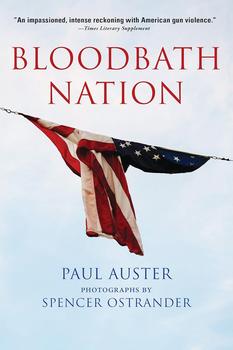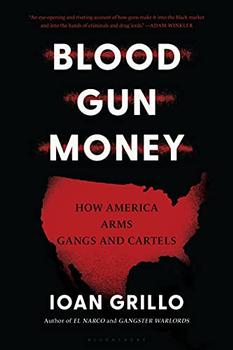Summary | Excerpt | Reviews | Beyond the book | Read-Alikes | Genres & Themes | Author Bio

In recent years, Booker Prize–nominated novelist Paul Auster has increasingly turned to nonfiction writing, including a prizewinning biography of writer Stephen Crane, as well as a pair of works that explore the culture of violence in America today. Long Live King Kobe zeroes in on one of the countless stories of families recovering from the trauma of loss. And now, in Bloodbath Nation, Auster takes a broader view of violence, specifically America's long love affair with guns and our culture's seeming tolerance of mass shooting events.
Auster opens the volume by acknowledging that even he—a Brooklyn-based intellectual—did not grow up immune to the allure of firearms. He recalls watching Westerns on television in suburban New Jersey in the early 1950s and being, as he puts it, one of the "legions of small American boys [who] were proud owners of a cowboy hat and a cheap toy pistol tucked into an imitation leather holster." As a young teenager, Auster freely confesses, he found pleasure in firing a gun at paper targets and clay pigeons. That romanticization of firearms, however, first began to fade as he entered adulthood and learned about a gun-inflicted death in his own family that prompted generations of trauma. Soon thereafter, when he joined the Merchant Marine, he became acquainted with two shipmates and their own troubling relationships to firearms.
These personal anecdotes—including Auster's acknowledgment of guns' allure—underpin the rest of his slim yet powerful work, which starkly outlines the grim statistics of American death by firearms—"Eighty thousand wounded and forty thousand dead, or one hundred and twenty thousand ambulance calls and emergency room cases for every twelve-month tick of the clock."—but also addresses the collective emotional toll of this unrelenting brutality.
In five short chapters, each of which reads more or less like a standalone essay, Auster compels readers to confront the ugliness of where we find ourselves, the ways in which we have come to expect gun violence in virtually every public and private realm, from schools and nightclubs to grocery stores and even churches and synagogues. He traces the links between social media, hatred and troubled young men's compulsion to be the next one to prompt sensationalistic headlines. Auster also touches on the tangled connections between political discourse and gun rights, though—like many Americans—he acknowledges that the answer to extracting ourselves from this epidemic is anything but simple. As he writes, "If the problem is too many bad men with guns, would it not be wiser to take those guns away from them rather than arm the so-called good men, who in many if not most instances are considerably less than good, and thereby eliminate the problem altogether, for if the bad men had no guns, why would the good men need them? As my mother used to say...'Dream on, Paul.'"
The chapters are interspersed with dozens of black-and-white photographs by Spencer Ostrander (see Beyond the Book), which are haunting not because they chronicle grisly images of survivors or victims but because they show places empty of people. They depict the ordinary, otherwise unremarkable sites—grocery stores, movie theaters, hotels, bars, schools and places of worship—that have become sites of grotesque violence. Accompanied by dates and statistics, these photos bear witness to those who were lost and are a reminder of just how ordinary injuries and deaths from firearms have become.
Readers who have already grappled with these issues in their own reading and thinking may find Auster's chapter tracing the history of gun rights in America overly rudimentary, but the other chapters more than outweigh that portion, which nevertheless serves as a good review. And, in the book's closing paragraphs, he brings the narrative back to the urgency of our present moment and possible futures, highlighting recent violence in the same small Wisconsin city where his family's tragedy played out more than a hundred years earlier and asking provocative questions about which direction—or directions—our society might choose to pursue. In these moments, Auster, writing in his 70s, grimly acknowledges that he's unlikely to see an end to this violence in his lifetime; perhaps the best audience for his book are young people just starting out as activists—but it can also benefit the rest of us, who need to be reminded daily not to grow numb to this epidemic.
![]() This review was originally published in The BookBrowse Review in February 2023, and has been updated for the
February 2025 edition.
Click here to go to this issue.
This review was originally published in The BookBrowse Review in February 2023, and has been updated for the
February 2025 edition.
Click here to go to this issue.

If you liked Bloodbath Nation, try these:

by Brian VanDeMark
Published 2025
A definitive history of the fatal clash between Vietnam War protestors and the National Guard, illuminating its causes and lasting consequences.

by Ioan Grillo
Published 2023
The gun control debate is revived with every mass shooting. But far more people die from gun deaths on the street corners of inner city America and across the border as Mexico's powerful cartels battle to control the drug trade.
Your guide toexceptional books
BookBrowse seeks out and recommends the best in contemporary fiction and nonfiction—books that not only engage and entertain but also deepen our understanding of ourselves and the world around us.